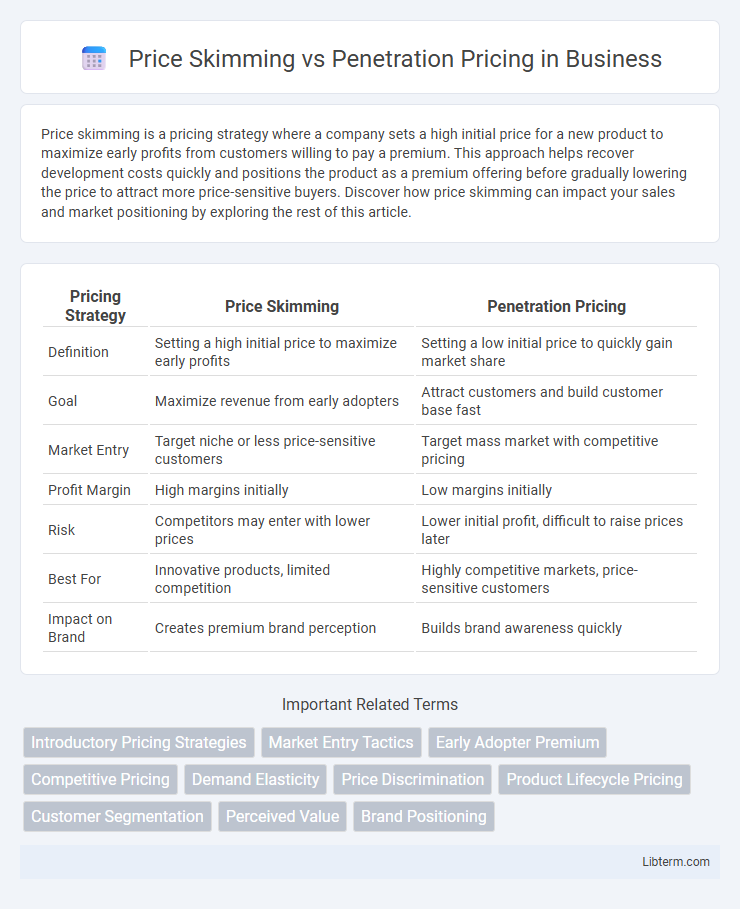Price skimming is a pricing strategy where a company sets a high initial price for a new product to maximize early profits from customers willing to pay a premium. This approach helps recover development costs quickly and positions the product as a premium offering before gradually lowering the price to attract more price-sensitive buyers. Discover how price skimming can impact your sales and market positioning by exploring the rest of this article.
Table of Comparison
| Pricing Strategy | Price Skimming | Penetration Pricing |
|---|---|---|
| Definition | Setting a high initial price to maximize early profits | Setting a low initial price to quickly gain market share |
| Goal | Maximize revenue from early adopters | Attract customers and build customer base fast |
| Market Entry | Target niche or less price-sensitive customers | Target mass market with competitive pricing |
| Profit Margin | High margins initially | Low margins initially |
| Risk | Competitors may enter with lower prices | Lower initial profit, difficult to raise prices later |
| Best For | Innovative products, limited competition | Highly competitive markets, price-sensitive customers |
| Impact on Brand | Creates premium brand perception | Builds brand awareness quickly |
Introduction to Pricing Strategies
Price skimming involves setting a high initial price to maximize profits from early adopters before gradually lowering it, effectively capturing different market segments over time. Penetration pricing sets a low initial price to quickly attract a large customer base and gain market share, often deterring potential competitors. Firms select these strategies based on product lifecycle, competition intensity, and target audience price sensitivity.
What is Price Skimming?
Price skimming is a pricing strategy where a company sets a high initial price for a new product to maximize revenue from early adopters willing to pay a premium. This approach targets consumers seeking the latest innovation and helps recover development costs quickly before gradually lowering prices to attract more price-sensitive customers. Price skimming is commonly used in technology sectors such as smartphones and electronics to leverage product novelty and brand positioning.
What is Penetration Pricing?
Penetration pricing is a marketing strategy where a company sets a low initial price for a new product to quickly attract customers and gain market share. This approach aims to discourage competitors from entering the market while building brand awareness and customer loyalty. By offering products at a lower price point, businesses stimulate demand and accelerate market penetration.
Key Differences Between Price Skimming and Penetration Pricing
Price skimming involves setting high initial prices to maximize profits from early adopters before gradually lowering them, while penetration pricing sets low initial prices to quickly gain market share and attract volume sales. Price skimming targets customers willing to pay a premium, leveraging product novelty or uniqueness, whereas penetration pricing aims to discourage competitors and build customer loyalty through affordability. The key differences lie in their pricing objectives, market entry strategies, and impact on profit margins and competition over time.
Advantages of Price Skimming
Price skimming enables companies to maximize profits by targeting early adopters willing to pay premium prices, leading to higher initial revenue. This strategy recovers research and development costs quickly and creates a perception of high quality and exclusivity around the product. It also allows businesses to segment the market effectively, adjusting prices downward gradually to capture more price-sensitive customers over time.
Advantages of Penetration Pricing
Penetration pricing accelerates market entry by setting low initial prices to attract a large customer base quickly, fostering widespread product adoption. This strategy increases market share effectively, deterring competitors from entering due to slim profit margins. Companies benefit from economies of scale and enhanced brand loyalty as customers integrate the product into their routine purchases.
Disadvantages of Price Skimming
Price skimming often deters price-sensitive customers due to its initially high prices, limiting early market penetration and reducing potential market share. Competitors may quickly enter the market with lower prices, forcing rapid price reductions and eroding profit margins. This strategy can also damage brand reputation if consumers perceive the pricing as exploitative or unfair.
Disadvantages of Penetration Pricing
Penetration pricing often results in low profit margins initially, which may strain cash flow and limit funds for marketing or product development. This strategy can create customer expectations for consistently low prices, making future price increases challenging and potentially damaging brand perception. Competitors may engage in price wars, further eroding margins and reducing overall market profitability.
Factors Influencing the Choice of Pricing Strategy
The choice between price skimming and penetration pricing depends heavily on market demand elasticity, competitive intensity, and product lifecycle stage. High innovation products with limited competition often benefit from price skimming to maximize early profits, while markets with price-sensitive customers and strong existing competitors favor penetration pricing to quickly gain market share. Additionally, factors like production costs, brand positioning, and long-term business goals significantly shape the selection of an optimal pricing strategy.
Which Pricing Strategy is Right for Your Business?
Price skimming suits businesses with innovative products and strong brand positioning, allowing them to maximize profits by targeting early adopters willing to pay a premium. Penetration pricing works best for companies aiming to rapidly increase market share by setting low initial prices to attract price-sensitive customers and discourage competitors. Choosing the right strategy depends on market demand elasticity, competitive landscape, and long-term business goals.
Price Skimming Infographic

 libterm.com
libterm.com